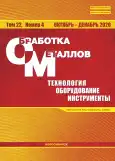Technological investigation of effect of machining parameter on tool life
- Authors: Sheladiya M.1, Acharya S.1, Acharya G.1
-
Affiliations:
- Issue: Vol 22, No 4 (2020)
- Pages: 41-53
- Section: TECHNOLOGY
- URL: https://bakhtiniada.ru/1994-6309/article/view/302003
- DOI: https://doi.org/10.17212/1994-6309-2020-22.4-41-53
- ID: 302003
Cite item
Full Text
Abstract
Keywords
About the authors
M. Sheladiya
Email: mvsheladiya@gmail.com
Ph.D. (Engineering), 1. Gujarat Technological University, Ahmedabad, 382424, India; 2. Atmiya University, Faculty of Engineering & Technology, Yogidham Gurukul, Kalawad Road, Rajkot, 360005, India, mvsheladiya@gmail.com
S. Acharya
Email: shailee.acharya@gmail.com
D.Sc. (Engineering), Sardar Vallabhbhai Patel Institute of Technology, Affiliated to GTU, Vasad, 388306, India, shailee.acharya@gmail.com
G. Acharya
Email: gdacharya@rediffmail.com
D.Sc. (Engineering), Professor, Atmiya Institute of Technology and Science, Yogidham Gurukul, Kalawad Road, Rajkot, 360005, India, gdacharya@rediffmail.com
References
- Sheikh-Ahmad J., Davim J.P. 5- Tool wear in machining processes for composites // Machining Technology for Composite Materials. – 2012. – P. 116–153. – doi: 10.1533/9780857095145.1.116.
- Paul S., Chattopadhyay A.B. Environmentally conscious machining and grinding with cryogenic cooling // Machining Science and Technology. – 2006. – Vol. 10, iss. 1. – P. 87–131. – doi: 10.1080/10910340500534316.
- Zakovorotny V.L., Lapshin V.P., Babenko T.S. Modeling of tool wear: irreversible energy transformations // Russian Engineering Research. – 2018. – Vol. 38, iss. 9. – P. 707–708. – doi: 10.3103/S1068798X18090290.
- Bhuiyan M.S.H., Choudhury I.A. Review of sensor applications in tool condition monitoring in machining // Comprehensive Materials Processing. – 2014. – Vol. 13. – P. 539–569. – doi: 10.1016/B978-0-08-096532-1.01330-3.
- Zhu K., Wong Y.S., Hong G.S. Multi-category micro-milling tool wears monitoring with continuous hidden Markov models // Mechanical Systems and Signal Processing. – 2009. – Vol. 23, iss. 2. – P. 547–560. – doi: 10.1016/j.ymssp.2008.04.010.
- Development of a tool wear-monitoring system for hard turning / C. Scheffer, H. Kratz, P.S. Heyns, F. Klocke // International Journal of Machine Tools and Manufacture. – 2003. – Vol. 43, iss. 10. – P. 973–985. – doi: 10.1016/S0890-6955(03)00110-X.
- Lee K., Dornfeld D.A. Micro-burr formation and minimization through process control // Precision Engineering. – 2005. – Vol. 29, iss. 2. – P. 246–252. – doi: 10.1016/j.precisioneng.2004.09.002.
- Shaw M.C. Metal cutting principles. – 2nd ed. – Oxford: Oxford University Press, 2005. – 672 p. – ISBN 9780195142068.
- Grzesik W., Zalisz Z. Wear phenomenon in the hard steel machining using ceramic tools // Tribology International. – 2008. – Vol. 41, iss. 8. – P. 802–812. – doi: 10.1016/j.triboint.2008.02.003.
- Dhar N.R., Paul S., Chattopadhyay A.B. The influence of cryogenic cooling on tool wear, dimensional accuracy and surface finish in turning AISI 1040 and E4340C steels // Wear. – 2001. – Vol. 249, iss. 10–11. – P. 932–942. – doi: 10.1016/S0043-1648(01)00825-0.
- Venugopal K.A., Paul S., Chattopadhyay A.B. Growth of tool wear in turning of Ti-6Al-4V alloy under cryogenic cooling // Wear. – 2007. – Vol. 262, iss. 9–10. – P. 1071–1078. – doi: 10.1016/j.wear.2006.11.010.
- Modelling of surface finish and tool flank wear in turning of AISI D2 steel with ceramic wiper inserts / T. Özel, Y. Karpat, L. Figueira, J.P. Davim // Journal of Materials Processing Technology. – 2007. – Vol. 189, iss. 1–3. – P. 192–198. – doi: 10.1016/j.jmatprotec.2007.01.021.
- Modeling flank wear of carbide tool insert in metal cutting / X. Luo, K. Cheng, R. Holt, X. Liu // Wear. – 2005. – Vol. 259, iss. 7–12. – P. 1235–1240. – doi: 10.1016/j.wear.2005.02.044.
- Симсиве Ж.В., Кутышкин А.В., Симсиве Д.Ц. Оценка износа твердосплавного режущего инструмента при механической обработке // Обработка металлов (технология, оборудование, инструменты). – 2012. – № 1. – С. 50–55.
- Metal machining: theory and applications / K. Maekawa, T. Obikawa, Y. Yamane, T.H. Childs. – 1st ed. – Oxford: Butterworth-Heinemann Publ., 2000. – 408 p. – ISBN 978-0340691595. – ISBN 034069159X.
- Microstructural aspects determining the adhesive wear of tool steels / G.A. Fontalvo, R. Humer, C. Mitterer, K. Sammt, I. Schemmel // Wear. – 2006. – Vol. 260, iss. 9–10. – P. 1028–1034. – doi: 10.1016/j.wear.2005.07.001.
- Khrais S.K., Lin Y.J. Wear mechanisms and tool performance of TiAlN PVD coated inserts during machining of AISI 4140 steel // Wear. – 2007. – Vol. 262, iss. 1–2. – P. 64–69. – doi: 10.1016/j.wear.2006.03.052.
- Influence of buildup in lathe processes on tool life and surface quality / S.G. Emel’;yanov, E.I. Yatsun, S.V. Shvets, A.I. Remnev, E.V. Pavlov // Russian Engineering Research. – 2011. – Vol. 31, iss. 12. – P. 1276–1278. – doi: 10.3103/S1068798X11120100.
- Machine tool design handbook / Central Machine Tool Institute (CMTI). – New Delhi: McGraw-Hill Education Publ., 1983. – P. 421–588.
- Sheikh-Ahmad J.Y., Bailey J.A. High-temperature wear of cemented tungsten carbide tools while machining particleboard and fiberboard // Journal of Wood Science. – 1999. – Vol. 45, iss. 6. – P. 445–455. – doi: 10.1007/BF00538952.
- Benardos P.G., Vosniakos G.C. Predicting surface roughness in machining: a review // International Journal of Machine Tools and Manufacture. – 2003. – Vol. 43, iss. 8. – P. 833–844. – doi: 10.1016/S0890-6955(03)00059-2.
- Khara J., Sheladiya M.V., Acharya G.D. Machining parameters optimization of AISI 4340 // IUP Journal of Mechanical Engineering. – 2019. – Vol. 12, iss. 2. – P. 43–64.
Supplementary files






